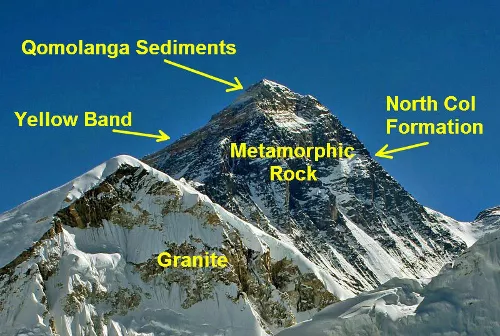Summary
The History of the World’s Tallest Mountain
The Himalayan range, topped by 29,035-foot Mount Everest, the tallest mountain in the world, is one of the largest and most distinct geographic features on the earth’s surface. This majestic range, running northwest to southeast, stretches 1,400 miles and varies in width between 140 miles and 200 miles. It crosses or abuts five different countries—India, Nepal, Pakistan, Bhutan, and the People’s Republic of China—serving as the origin for three major rivers: the Indus, Ganges, and Tsampo-Bramhaputra. Moreover, it boasts over 100 mountains that soar beyond 23,600 feet.
Formation of the Himalayas
Geologically speaking, the Himalayas and Mount Everest are relatively young. They began forming over 65 million years ago when two of the earth’s great crustal plates—the Eurasian plate and the Indo-Australian plate—collided. The Indian subcontinent moved northeastward, crashing into Asia. This collision folded and pushed the plate boundaries until the Himalayas ultimately grew to over five miles in height. The Indian plate is moving northward at an impressive rate of about 1.7 inches per year, slowly subducted by the still and powerful Eurasian plate. Consequently, both the Himalayas and the Tibetan Plateau continue to rise at an estimated rate of 5 to 10 millimeters each year. Geologists project that India will further advance northward for nearly a thousand miles within the next 10 million years.
Peak Formation and Fossils
As two crustal plates collide, heavier rock is pushed back down into the earth’s mantle at the point of contact. Simultaneously, lighter rock, including limestone and sandstone, is pushed upward to create the towering mountains. At the tops of the highest peaks, such as Mount Everest, one can discover 400-million-year-old fossils of sea creatures and shells that were deposited in shallow tropical seas. Nowadays, these fossils are situated at the roof of the world, over 25,000 feet above sea level.
Marine Limestone
The peak of Mount Everest consists of rock that was once submerged beneath the Tethys Sea, an ancient waterway that existed between the Indian subcontinent and Asia over 400 million years ago. Nature writer John McPhee considers this fact to be the most critical aspect of the mountain:
When the climbers in 1953 planted their flags on the highest mountain, they set them in snow over the skeletons of creatures that had lived in the warm clear ocean that India, moving north, blanked out. Possibly as much as twenty thousand feet below the seafloor, the skeletal remains had turned into rock. This one fact is a treatise in itself on the movements of the surface of the earth. If by some fiat I had to restrict all this writing to one sentence, this is the one I would choose: The summit of Mt. Everest is marine limestone.
Sedimentary Layers
The sedimentary rock layers on Mount Everest include limestone, marble, shale, and pelite; below these lie older rocks including granite, pegmatite intrusions, and gneiss, a metamorphic rock. Notably, the upper formations on Mount Everest and the neighboring Lhotse are replete with marine fossils.
Main Rock Formations
Mount Everest is composed of three distinct rock formations. From the mountain base to the summit, these formations are: the Rongbuk Formation, the North Col Formation, and the Qomolangma Formation. Each of these rock units is separated by low-angle faults, positioning one over the next in an intricate zigzag pattern.
The Rongbuk Formation consists of the basement rocks below Mount Everest. The metamorphic rocks include schist and gneiss, a finely banded material. Interspersed within these ancient rock beds are large sills of granite and pegmatite dikes, formed when molten magma flowed into cracks and solidified.
The complex North Col Formation, beginning about 4.3 miles up the mountain, is categorized into several distinct sections. The upper section is distinguished by the famous Yellow Band, a yellow-brown rock band of marble, phyllite containing muscovite and biotite, alongside semischist, a slightly metamorphosed sedimentary rock. Below the Yellow Band are alternating layers of marble, schist, and phyllite. The lower section comprises various schists comprised of metamorphosed limestone, sandstone, and mudstone. At the bottom of this formation lies the Lhotse detachment, a thrust fault that delineates the North Col Formation from the underlying Rongbuk Formation.
The Qomolangma Formation, the highest rock section on the summit pyramid of Mount Everest, consists of layers of Ordovician-age limestone, recrystallized dolomite, siltstone, and laminae. This formation initiates at approximately 5.3 miles up the mountain, starting at a fault zone above the North Col Formation, and concludes at the summit. The upper layers are rich in marine fossils, including trilobites, crinoids, and ostracods. A notable 150-foot layer at the bottom of the summit pyramid holds remains of microorganisms, including cyanobacteria deposited in shallow, warm water.




